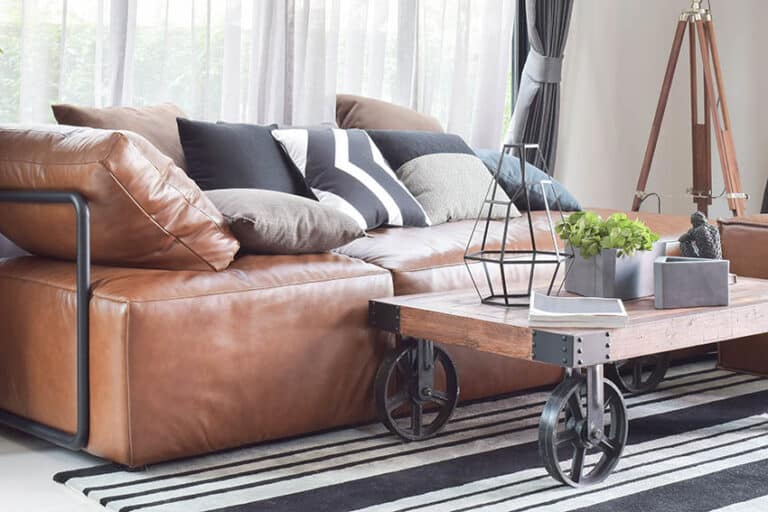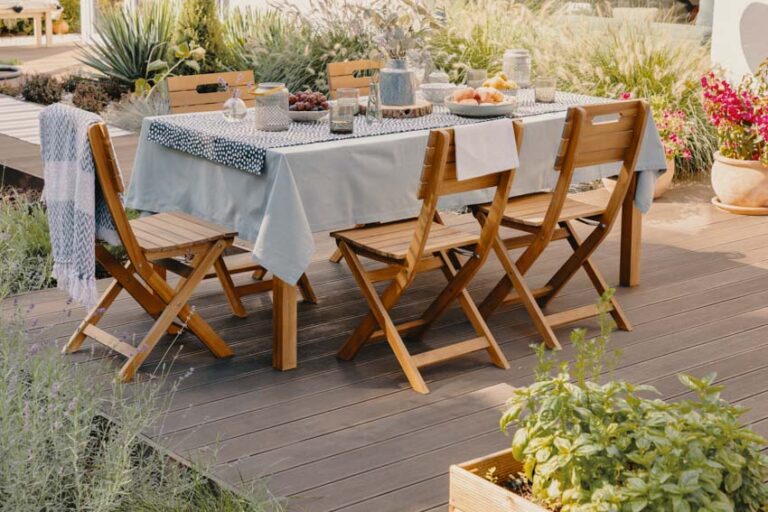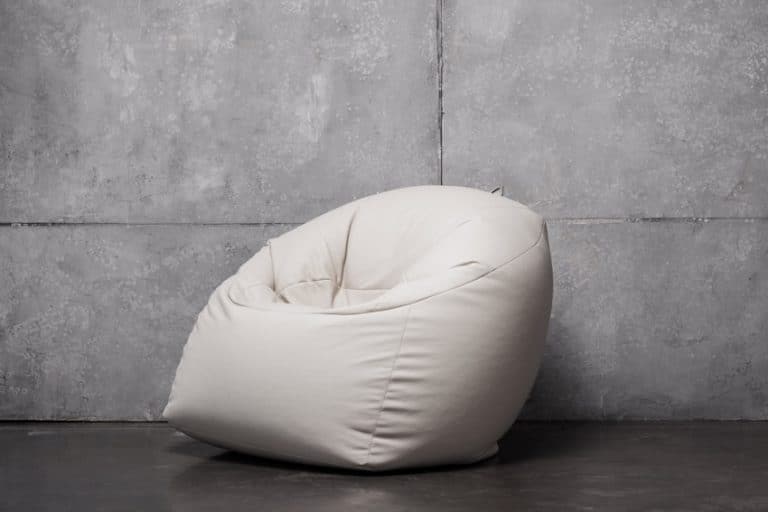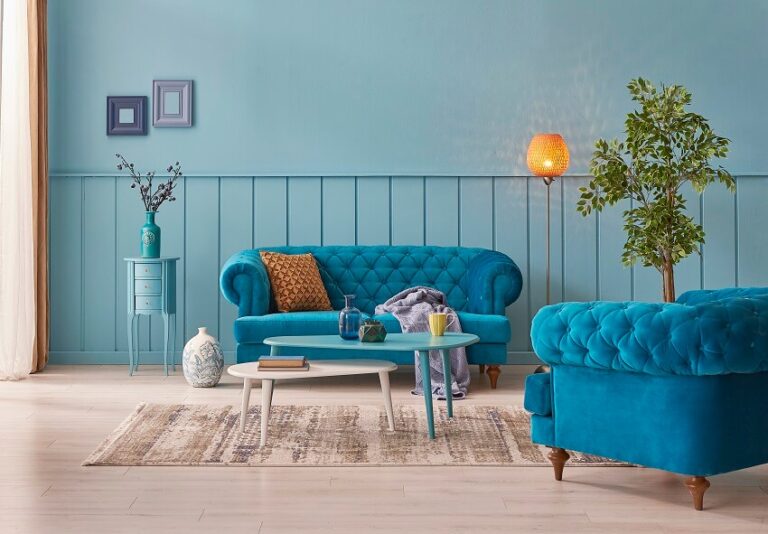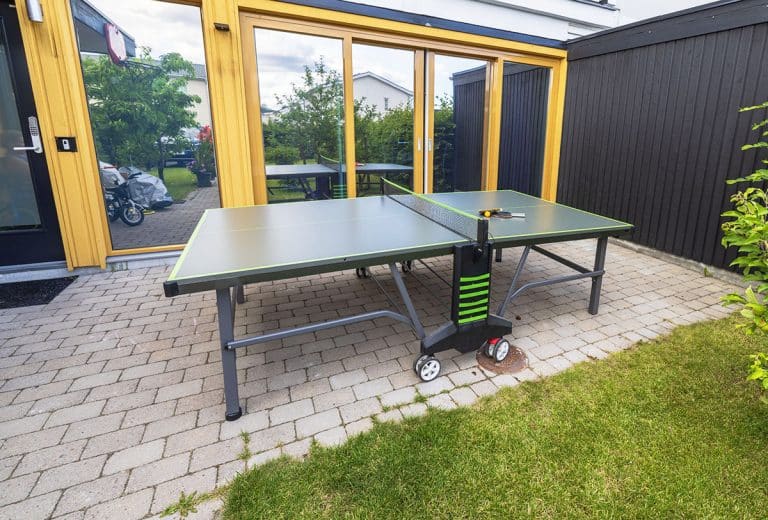8 Common Mistakes When Buying A Sofa: Designer Buying Tips

Buying a sofa can be quite overwhelming- not only are there thousands of options, but also small details that you can easily overlook, which leads to common mistakes when buying a sofa. Then, there also comes added pressure because a sofa is a large piece of furniture used daily. To avoid mistakes when buying a sofa, you should have a guide to help you prepare for this big purchase.
- Ignoring Measurements: One of the biggest mistakes you can make is buying the wrong size furniture for your room. Accurately measure the room, doorways, and the sofa itself to ensure you have room to move and place other furnishings.
- Overlooking Comfort: No one want to sit on an uncomfortable couch, ensure it looks good and you like how it feels.
- Neglecting to Test the Sofa: Make sure you test it out before you buy to ensure it doesn’t just look good.
- Choosing the Wrong Fabric: Have a busy household? By choosing a fabric that isn’t durable or is difficult to clean can lead to maintenance issues later on.
- Not Considering Lifestyle Needs: Consider how the piece will be used. Whether you’re planning on entertaining, lounging, or hosting guests, make sure you have a couch that meets your needs.
- Skipping Quality Checks: Check out the sofa’s construction, such as the frame, springs, and cushioning to make sure its of high quality. You should also seek out online reviews to see how people rate it after some longer term use.
- Ignoring Color and Style Coordination: Choosing a sofa that doesn’t match the existing décor can be a design faux-pas. Get a color swatch to compare before moving pieces into your interior.
- Consider Warranty and Return Policies: Does the store allow for returns and offer a warranty? Knowing the return policy and warranty details are important if the sofa has defects or doesn’t meet expectations.
Below, we have gathered our very own buying guide for sofas, along with some tips on how you can make your investment worthwhile.
What To Consider Before Buying a Sofa
Before deciding on which sofa you should buy for your home, there are several factors that you need to consider first.
• Purpose of the sofa: The first factor you must consider when choosing a sofa is the purpose for which you intend to use it. For example, if you need a sofa to sit on for long hours, opt for one with comfortable cushions, a reclining back, and a fabric that can withstand wear and tear.
If your sofa is for decorative purposes and is meant to be used as an accent chair, choose a statement piece with an interesting aesthetic. If you plan on using it in front of a TV, look for a sofa for lounging.
Additionally, your lifestyle and the number of users are equally important because they will help you determine the size of sofa you need.
• Size of the space: Imagine finding out that your newly purchased sofa can’t fit through your door once it gets delivered. To avoid the hassle, note that the size of the space also plays a significant role in choosing the best sofa for your home.
Consider the overall living room dimensions, and the size of your doorways, hallways, and clearances. If your chosen sofa is too big for the doors of your house, it will be hard to move it around and make it fit.
• Layout of the space and the existing architectural features in it: The layout of the space is another crucial factor that needs to be considered when buying a sofa — is your living room just rectangular? Or is the overall area irregular? Will the clearance be enough once you set up the sofa with a coffee table?
Additionally, are there any architectural features that need to be accounted for, like an alcove, a column, or a post? Analyzing the layout and the interior features of the space can also help you decide if you need a right-handed or left-handed corner sofa.
• Size of the sofa: Relative to the size of the space is the size of the sofa. One of the biggest mistakes people make when buying a sofa is choosing one that is too big or too small. Make sure to measure the sofa’s length, depth, and width and allow for some added clearance around it for efficient traffic flow.
The depth of the sofa is a critical factor because this can help you work out if the sofa needs to be tipped sideways to get through your home’s entryways. Since the sofa is also the largest piece of furniture in a living room, it is important to make sure that its size is well proportioned and balanced to the whole space, especially when all the other furniture pieces are set up.
• Style of your home: Another mistake you don’t want to make is to buy the wrong style of sofa. Aside from being comfortable, your sofa must fit the overall style of your home — whether traditional, transitional, contemporary, or modern.
Also, make sure to coordinate it with the color palette of the space. If you want it to blend, go for a neutral shade, while if you want it to stand out, choose a contrasting fabric color.
• Quality of the sofa: Buying a good quality sofa can help you save money over time because you do not have to replace it for years. The best quality sofa has cushions that won’t change shape even when used all the time, is comfortable to sit on for long periods, and will keep looking good.
At the same time, a poor-quality sofa has an unstable frame, thin types of cushions, and legs and arms that move. Opt for sofas that have hardwood or high-quality metal frames because these are the ones that are built to last. They may cost more but prove to be wise investments.
• Fabric of the sofa: Choose your upholstery fabric based on how you will be using the couch. Delicate fabrics are not suitable for heavy use. If you have children at home or take care of pets, opt for a reliable fabric like microfiber because it is durable and easy to maintain.
• Budget: The budget also plays an important role in choosing the right sofa for your home. Always make sure to look for at least three options, so you have a good basis for comparison when making your final decision.
Sofa Shopping Tips
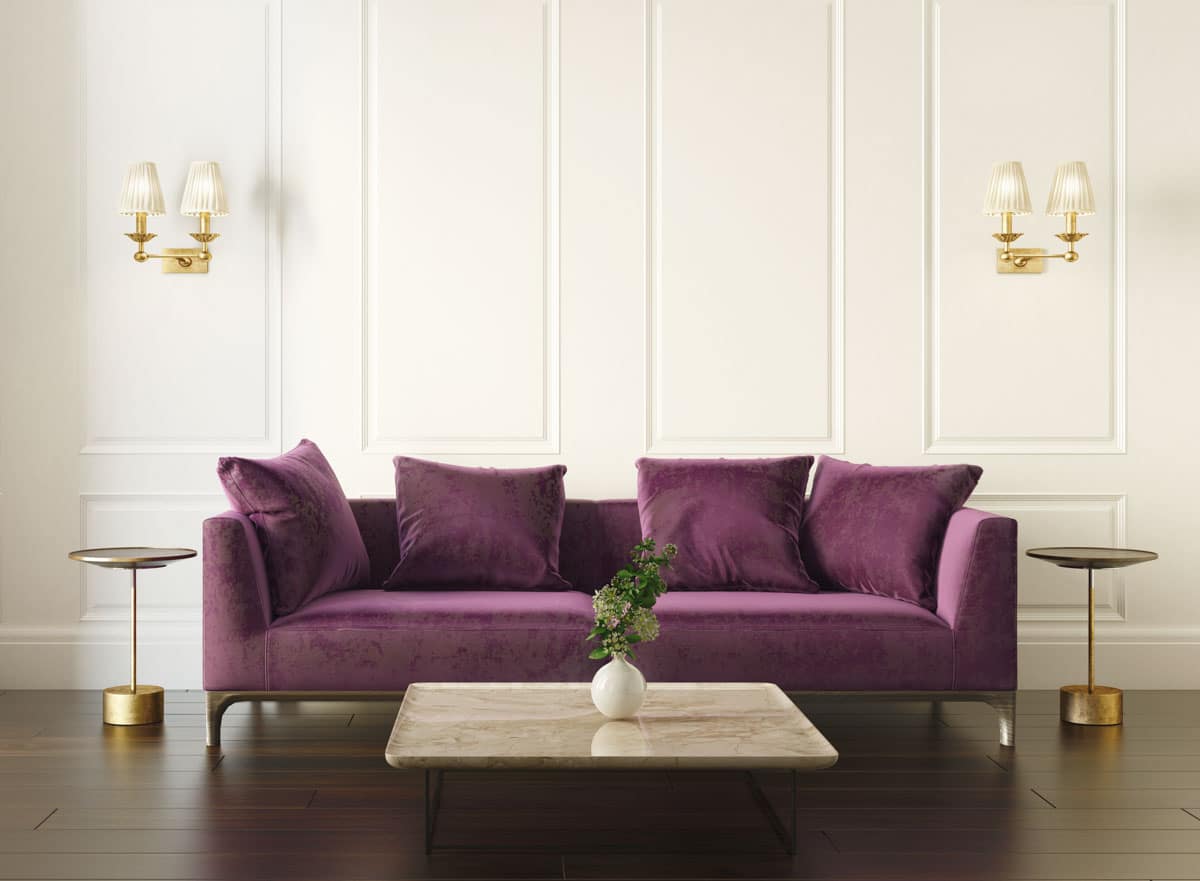
Here are some practical tips you can use when buying your sofa to make sure you don’t make any mistakes:
• Make sure to try out the sofa before buying it. Do not be afraid to try out the furniture in the showroom before deciding on whether you want it for your home. Sit on it or even lie on it so you’ll know if it fits the comfort you require. Make sure that the seat is deep enough, the arms are the right height, and the back is as high as you want it to be.
• No matter how good a couch looks online, do not decide based on the looks alone. Try to see it in person because, more often, they look and feel different than you picture them to be.
• If possible, request fabric swatches so you can see if the sofa upholstery matches your home’s wall color and floor finish.
• If you are buying a sofa for long-term use, never opt for something that is trendy at the moment. Opt for a classic style instead because their looks are timeless.
• Comfort is as equally important as aesthetics. Never decide on the looks alone because your sofa needs to be a practical furniture piece.
• Loose cushions and removable covers are a wise choice, especially if you have kids and pets at home. You can’t always avoid messes, and in the event that the couch gets dirty, you can always easily clean and wash it when needed. Additionally, removable colors can be replaced if you get tired of the color.
• Many sofa manufacturers offer customization, so don’t hesitate to take advantage of it. You can change the type of fabric, the style of the legs, and even the size of the sofa. This will make sure that your sofa perfectly fits your personal taste and requirements.
• Always check the warranty. Sofas typically come with a warranty, and this can be useful for unexpected issues when you start to use them. Most come with a 5-year frame warranty.
• Aside from measuring the size of the space, examine it for any existing obstructions like built-ins and shelvings that may cause problems when maneuvering your furniture.
• Loose covers are wise options because they can be removed easily and cleaned whenever needed. Slipcovers are also a wise choice because you can easily change them if you want an updated look.
Types of Sofas to Choose From

Sofas come in different styles, shapes, and sizes. Most of them are characterized by the shape of their arms and back and the number of pieces they have. Below is a look at the different types of sofas you can choose from:
Sectional Sofas: Sectional sofas are one of the most versatile pieces of furniture. These are made up of multiple individual seating pieces, typically three to five, which can be arranged and rearranged according to your space and needs. The most common sectional sofa design includes seat cushions and back support cushions, which are usually arranged in a U- or L-shaped layout.
Mid-Century Modern Sofas: Clean aesthetics, sharp lines, and minimalist design – these are the key characteristics of mid-century modern sofas, which were popularized from the 1930s to 1970s. These timeless pieces are marked by their clean lines, organic shape, and simplicity.
Chesterfield Sofas: Loved for their classic form and strong appearance, Chesterfield Sofas are another type of traditional sofas that stood the test of time. It is characterized by its large size, structured tufted back, nailhead trims, rolled arms, and rich leather upholstery.
Sleepers and Sofa Beds: Sleepers and sofa beds are pieces that can be converted into a bed. The difference between the two is that sleeper sofas are typically pulled out to make a bed.
Whether as a primary sleep surface or just for guests, it’s a very effective, space-saving type of furniture. They’re also called a hide-a-bed or sleeper-sofa. – 101 Tips for Better And More Healthy Sleep, Alan E. Smith
Meanwhile, a sofa bed is usually laid out flat. Because of these sofas’ versatility, they are perfect for homes with limited space.
Loveseat Sofas: A “loveseat” is a couch that can comfortably seat two people. They come in an average size of 52 inches to 71 inches long. Small loveseats are 52 inches long, medium-sized loveseats are 58 inches long, and full loveseats are up to 64 inches long.
Relax Sofas: As its name suggests, there are sofas with backs that allow you to recline and footrests that lift. They typically come with a mechanism that moves the backseat and sometimes the headrest too.
Divan: A divan is a sofa without a back. It is typically placed against a wall and furnished with pillows. Although not as comfortable for seating because of its backless design, divans are perfect for lounging and lying down.
Ottomans: Ottomans are a single piece of furniture, typically smaller than a regular sofa, that have small cushioned seats. Their design does not include arms or a back, and they are usually used as a footstool. Variations of the ottoman include ottomans with storage or those that have extra space for small items underneath the seat.
Chaise Lounge: Also called a “chaise”, a chaise lounge is an elongated upholstered couch that is designed for lounging. It may or may not have arms and is perfect to be used for a half-sitting or half-lying position. Chaise lounges typically have traditional designs that are very luxurious, which makes them suitable for use in bedroom suites.
Sofa Measurements to Take
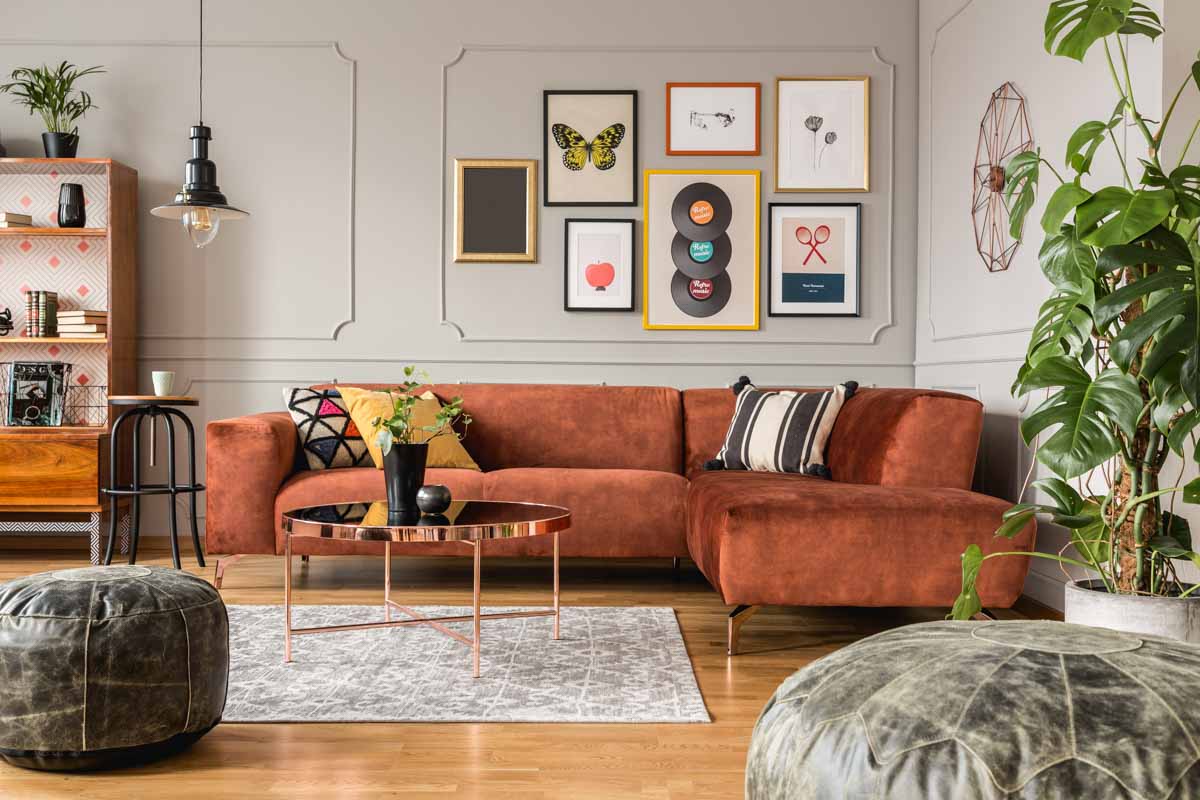
It is crucial to take accurate measurements of your chosen sofa before making the final decision to buy it. Not only to ensure that it perfectly fits in the space but also for proper scale in relation to other furniture items and the ease of delivery.
There are four important measurements that you need to take: length, height, depth, and diagonal depth. Below is a guide on how to measure a sofa:
• Height: Measure the back at the highest point on the floor. If your couch has an arched-back design, measure at the center.
• Depth: Measure from the outside edge of the seat all the way to the back. You can do this from one of the sofa’s sides.
• Diagonal Depth: The diagonal depth pertains to the diagonal measurement from the back of the frame to the front of the arm. Using a straight tape measure, measure from the top back of the frame to the bottom front on opposite sides.
• Length: The overall length of the sofa is the measurement from one arm to another. Take these measurements at the widest point of the sofa. For example, if your couch has rolled arms, measure from the outside of the arm to the other arm.
Measuring the Room Space
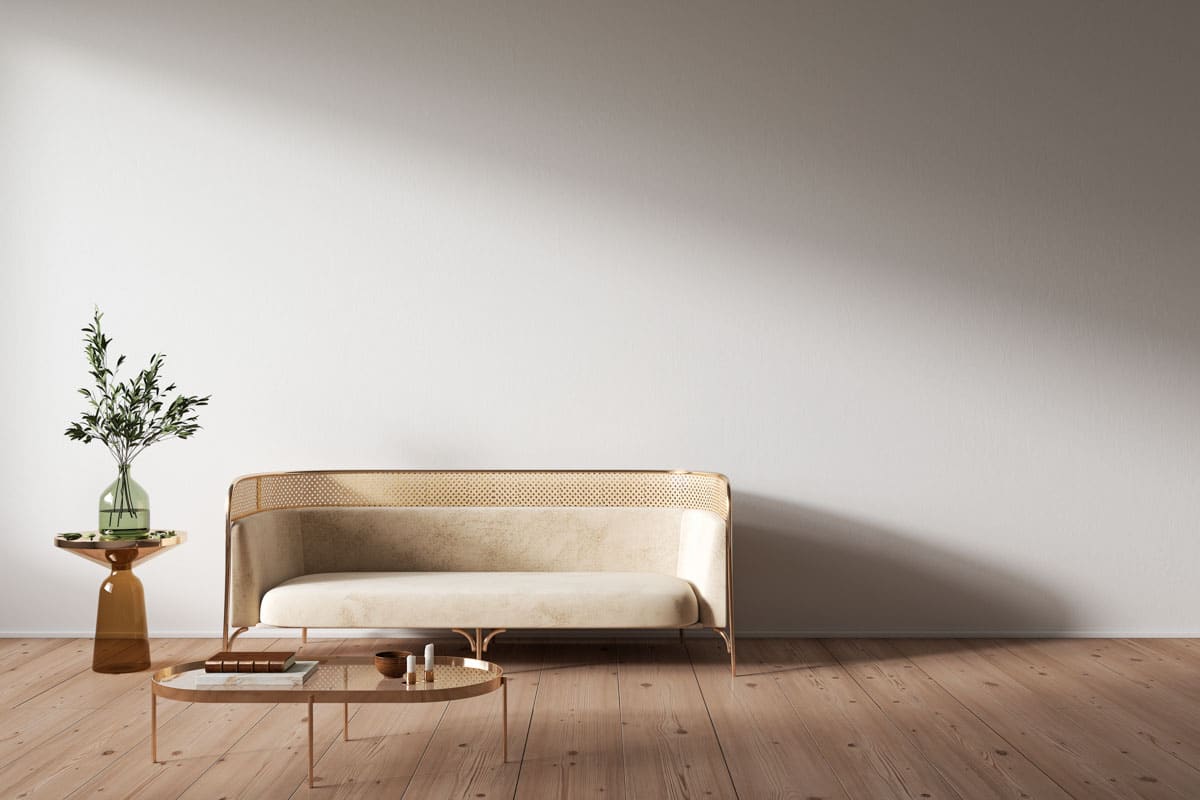
If you need to learn how to measure a room for furniture, a rule of thumb for a sofa scaled right for the space is that it should be about 2/3 the size of the area.
Start from the entry, then move on to all the passages, hallways, staircases, or doors that your couch will pass through to get to where it is supposed to go. Make sure to leave a few extra inches for maneuvering your furniture.
Sofa Upholstery Options
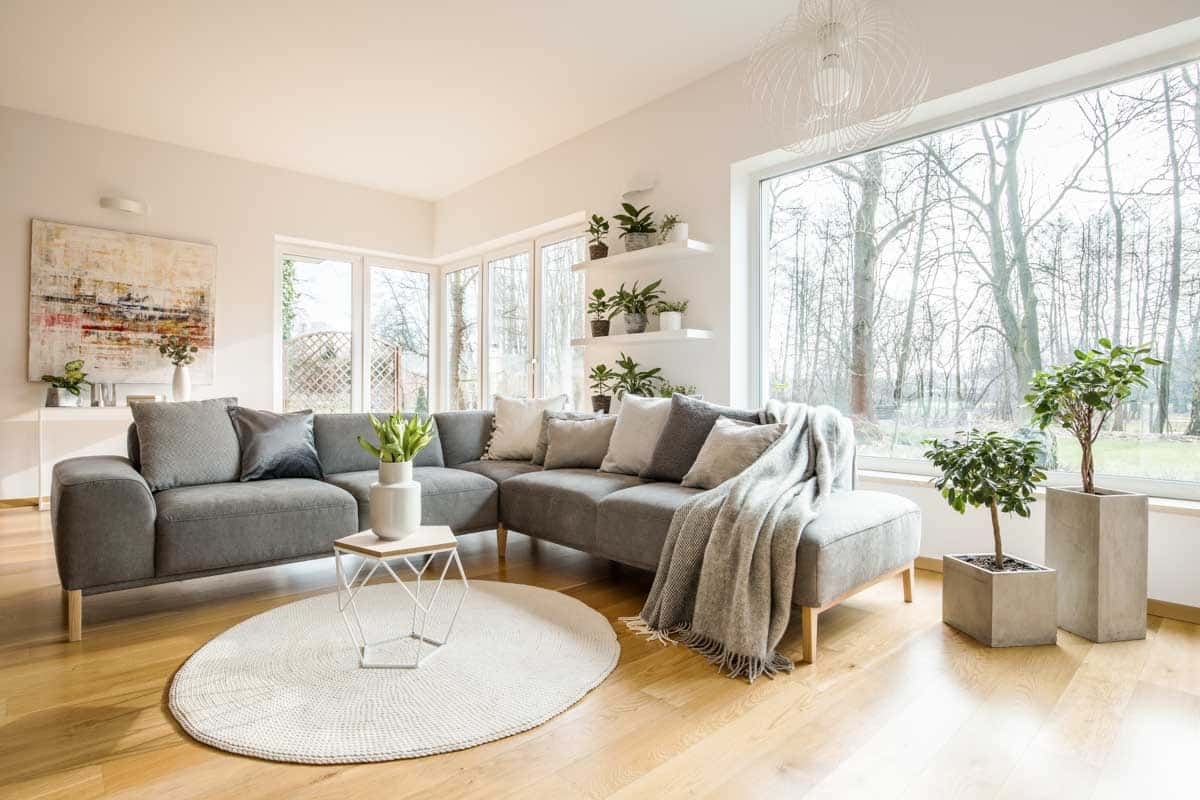
There are hundreds, if not thousands, of fabrics used as upholstery for sofas. But in general, they are classified into natural and synthetic fabrics. Each of the sofa fabric types has its own unique properties and advantages, which make them ideal as a couch covering.
Below is a look at the different types of upholstery fabrics for sofas:
Natural Fabrics: Natural fabrics are made with fibers that come from plants, animal skin, or hide. These are the best sofa upholstery to use if you want something soft and comfortable. Some examples of natural fabric upholstery include cotton, leather, wool, silk, and linen fabric.
• Cotton: Cotton is the most widely used natural fiber. Not only is it the cheapest, but it offers the most comfort because of its soft feel. Cotton is also very durable and resistant to fading however, it can be susceptible to staining.
• Silk: Silk is one of the most expensive natural fabrics in the market. It is made from fibers from the silkworm and is well known for its distinct luxurious feel and natural luster. Silk upholstery is not suitable for heavy use because it is not as durable as other fabrics. Once it gets spilled on, silk upholstered sofas need to be professionally cleaned.
• Wool: Wool is best known for its durability. Derived from the fur and hair of animals like sheep and goats, wool is naturally resistant to pilling and staining, making it one of the best upholstery options for used sofas. There is, however, a drawback to it: wool tends to develop an unpleasant odor once it gets wet
• Leather: Derived from the hide of animals like cows and pigs, leather is perhaps the most durable upholstery for sofas. Aside from its rich, luxurious looks, leather offers maximum comfort. It is a great option for high-traffic areas and for households with pets because they resist dander.
• Linen: Linen is another popular fabric used for upholstery. Derived from flax plants, linen has a woven appearance and a laid-back casual feel to it. This type of upholstery is more suitable for lightly used sofas because it wrinkles and stains easily.
Synthetic Fabrics: Synthetic upholstery fabrics consist of man-made fibers that are manufactured with superior durability.
• Polyester: Polyester is a synthetic fiber that is typically blended with other types of fibers like cotton to reinforce their durability. It retains dyes easily, is easy to maintain, and very durable. You can usually find it on outdoor sofas.
• Olefin or Polypropylene: Next to polyester, olefin is the second most produced synthetic fiber. It is best known for its durability and resistance to fading, staining, mold, and mildew growth.
• Nylon: Nylon is another type of synthetic fiber that is more commonly blended with other natural and synthetic fibers. When combined with other fibers, nylon helps eliminate napping. This is typically combined with velvet and chenille to make a more durable upholstery fabric.
• Acrylic: Acrylic is an imitation of wool and is more commonly used for outdoor sofas. It is resistant to soiling, wrinkling, and fading.
• Rayon: Rayon is an imitation of cotton, silk, and linen. Compared to these natural fabrics, nylon is more durable. However, it is susceptible to wrinkling.
Sofa Cushion Fillings
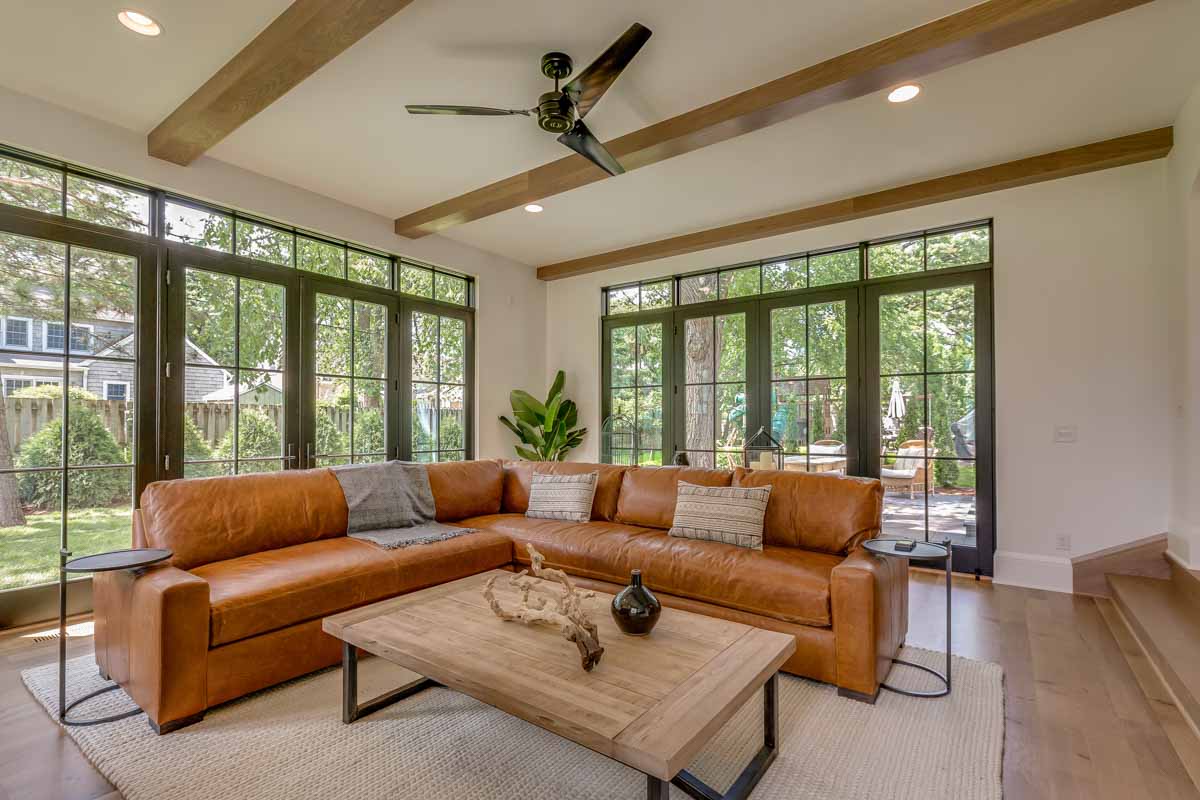
Similar to the way you pick your upholstery fabric, cushion fillings must be chosen based on how you’ll use your sofa. If intended to be used for sitting for long hours, opt for one that has maximum durability, while if you plan on using it as an extra bed, make sure to look for cushions that have superior comfort.
Aside from comfort, other factors to consider when choosing the right cushion filling for your couch include waterproof qualities, resistance to staining, and cost. Cushion fillings for sofas are generally categorized into three: foam fillings, feather fillings, and fiber fillings.
Below is a look at the most popular cushion fillings for sofas:
• Foam fillings: Considered to be the most basic form of couch cushion, foam is made from manufactured flexible polyurethane. The more urethane used, the denser the foam, thus the more expensive it is. Foam can be cut into any size and shape and has both firm and soft options. This is the best option if you want supporting seating.
The best quality that foam cushions offer is that they can retain their shape for a very long time, especially those used in for a one cushion sofa. However, they are still recommended to be plumped every 2 weeks and turned every month to keep them in good shape.
• Fiber fillings: In general, fiber fillings offer a lot of comfort because of their softness. Hollow fiber or ball fiber are the two major forms of fiber fillings used for cushions. Hollow fiber has an appearance similar to candy floss and has a medium-firm feel. It is more popularly used for soft toys but also commonly used for cushions.
This type of fiber filling is ideal for those with allergies. Ball fiber, is another type of fiber filling that is made of small round balls. It is very soft and easily bounces back to its original shape. Just like hollow fiber, ball fiber is hypoallergenic, light, and washable. Both types of fiber cushion filling require it to be shaken once in a while to keep its shape.
• Feather or Down fillings: Feather or down is the most expensive type of cushion fillings. Gathered from ducks, geese, and other birds, feather fillings offer the most comfort and give sofas a premium, expensive feel. The main advantage of this type of cushion filling is that it stays warm and holds heat very well.
On the downside, they absorb spilled liquids very easily and are not hypoallergenic. This type of cushion also needs to be plumped daily to avoid misshaping them. The price point for feather filings depends on the grade of the feathers, duck feathers being the cheapest.
Quality of Sofa Materials

To know the quality of materials used in a sofa, you must carefully examine its parts and inquire about the frames, joints, cushions, and fabric upholstery used. The best quality sofas have sturdy frames that are made with hardwood like birch, maple, walnut, oak, and bamboo.
The framing joints are glued, firmly screwed, or in some cases dowelled. When it comes to the cushions, use premium fiber, foam, or feather fillings that are soft and comfortable. Lastly, the upholstery fabric is made of high-quality material that not only looks luxurious but is also durable, like heavy-duty microfiber.
Sofa Price Points
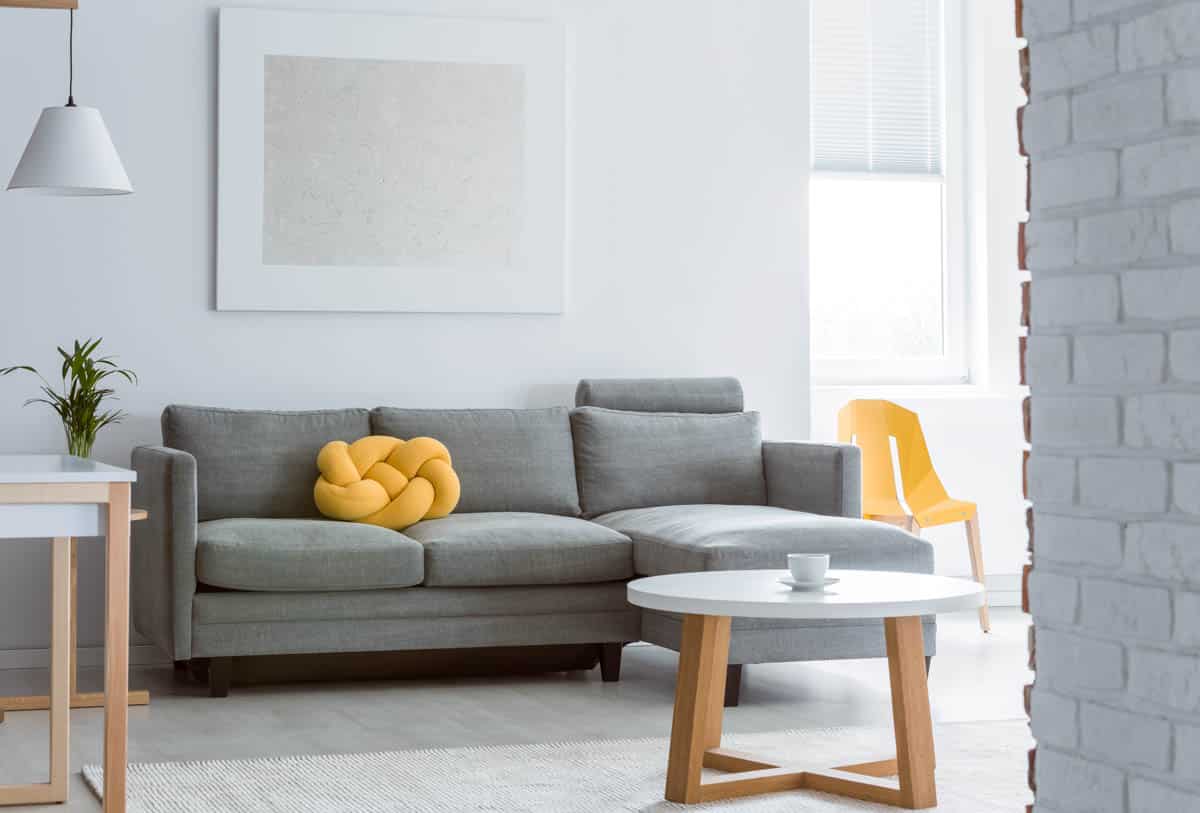
Sofas come with different price points depending on the type and quality of materials used in its construction. The typical range for sofas cost around $300 to $3000. The price points can be categorized into three, namely high-end, mid-range and budget sofas. Here’s a closer look at today’s market for sofas:
• High End: The most expensive options for sofas range around $3000 to $10,000 per piece. These sofas commonly have luxurious materials, extra-long seats, and automatic mechanisms like power reclining. High-end sofas are usually made to order.
• Mid Range: Between the highs and lows, you can find mid-range sofas that cost $1,500 to 3,000. These are usually made with specialty weave fabrics and often have 3 to 4-seat sectional pieces.
• Budget: The cheapest couch options range from $300 to $1,500 for a small 2 or 3-seater piece. These sofas are usually mass-produced and have a five to ten-year lifespan.
Upholstery not only plays a massive role in the overall look, but it also greatly impacts the price. Luxury fabrics like genuine leather and performance fabrics cost a lot more than options like cotton, polyester, and synthetic fabrics.
Budget-friendly upholstery also includes faux leather. For the mid-range, you can find non-cotton natural fabrics like linen and textile specialty weaves, like those found in a twill or velvet sofa.
Sofa Delivery and Assembly
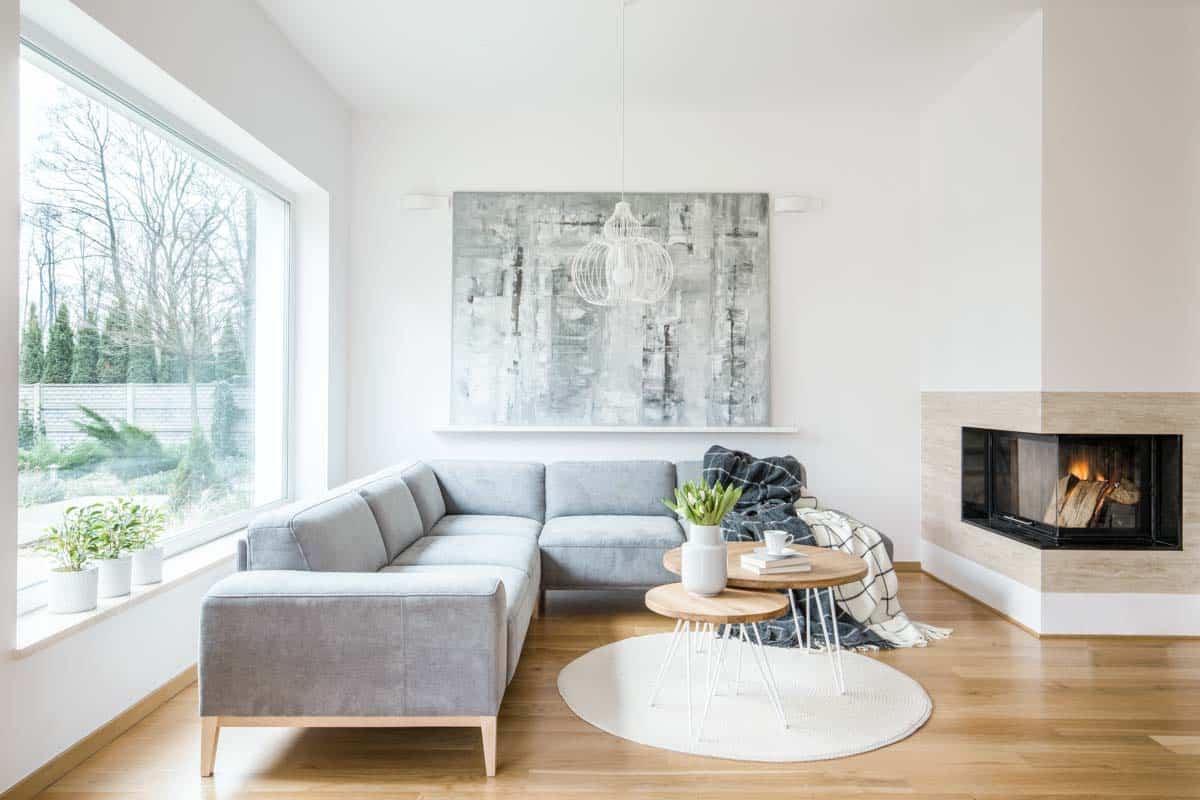
Delivery and assembly for sofas would vary from one supplier to another. But in general, you can purchase them in three ways: fully assembled, partly assembled, and unassembled.
With fully assembled options, the couch is delivered whole to your home and would not require any fitting together. Customized furniture pieces often come fully assembled and ready to use.
Part-assembled sofas, on the other hand, are delivered in components and can be assembled in minutes without the use of tools. For example, modular sofas and sectionals come in units and modules, which are typically delivered with backs, arms, and legs unattached to each other.
Unassembled sofas are those that require full assembly upon arrival. Some manufacturers offer assembly service once the item is delivered. However, you can still find knock-down or flat-pack pieces that are easy to put together. These are also known as “sofa in a box,” which ships in compact boxes and doesn’t require much assembly time.
During delivery, make sure to check your sofa for any damages. If they come unassembled, check if all the parts are complete.
Sofa Maintenance and Cleaning
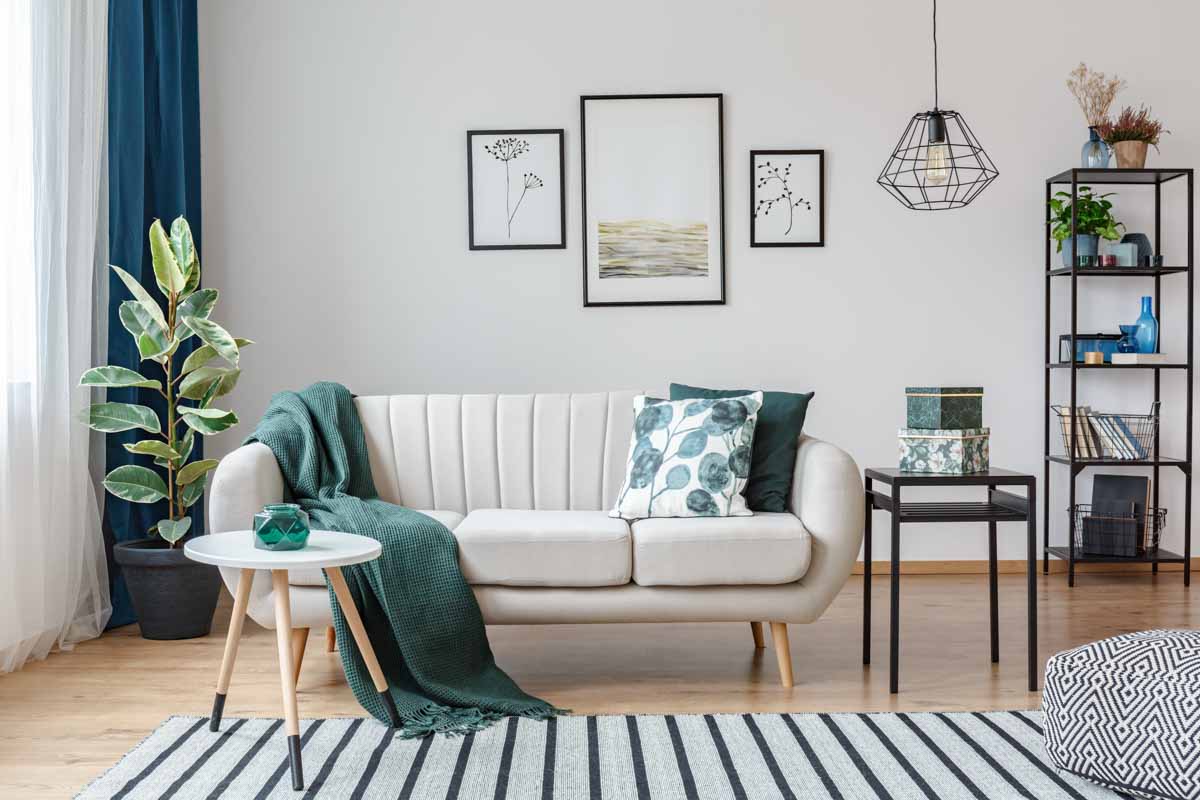
Aftercare is what makes your sofa last longer. Even if you buy a high-quality piece of furniture, if you do not care for it properly, it will look worn out quickly. To keep your sofa looking its best, try the following tips for sofa care, maintenance, and cleaning.
How to Maintain Your Sofa
• Daily upkeep: Clean any spilled liquids fast so they don’t leave a mark on your upholstery. Use a dry cloth to blot the affected area.
• Weekly maintenance: Lightly vacuum your sofa to remove any dirt and dust. Then, clean with a soft fabric brush.
• Periodic maintenance: Fluff your cushions as needed, depending on its material. Some cushions need to be rotated regularly to make them last long.
Tips to Care For Your Sofa
• There are some products you can use to give your sofa added durability. Research these products so you know whether you can apply them to the upholstery.
• Use throws to cover your sofa. Not only are they decorative accessories, but they also protect it from dust and stains.
• Make sure to read the manufacturer’s instructions for proper care. Some fabrics are sensitive to specific products and can get damaged once in contact. The instructions would differ based on the type of fabric used for upholstery.
• Regular professional services for deep cleaning are available at least once a year.
• Some sofas have loose cushions with removable covers, and they can be washed. However, most of these covers cannot be tumbled dried because they may shrink.
• Avoid exposing your upholstery to direct sunlight for prolonged hours because it may cause the fabric to fade.
• Avoid using commercial detergents when cleaning spills in fabric sofas, but instead, mix warm water with some mild soap.
• Leather sofas age gracefully. Over time, it develops slight markings and creases that add to its natural beauty. To care for this type, dust its surface with a dry microfiber cloth.
• Sofa upholsteries that have “naps” or raised surfaces can be fixed by brushing them softly with a clothes brush. One example of this is a velvet fabric.
See more related content in our article about sofa vs. couch on this page.

